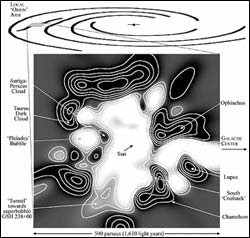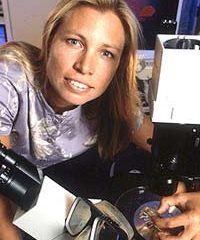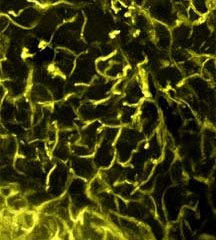
The first detailed map of space within about 1,000 light years of Earth places the solar system in the middle of a large hole that pierces the plane of the galaxy, perhaps left by an exploding star one or two million years ago.
The new map, produced by University of California, Berkeley, and French astronomers, alters the reigning view of the solar neighborhood. In that picture, the sun lies in the middle of a hot bubble – a region of million-degree hydrogen gas with 100-1,000 times fewer

University of California, Berkeley’s RHESSI satellite, launched last year by NASA, was snapping X-ray pictures of solar flares in December when it caught an extremely bright background gamma-ray burst, revealing a novel physical feature of these gamma rays – their polarization.
The result sheds new light on the driving force behind these mysterious explosions.
Gamma-ray bursts are mysterious flashes of gamma-ray photons that pop off about once a day randomly in the sky, briefl

Scientists have discovered that seaweeds defend themselves from specific pathogens with naturally occurring antibiotics. The finding helps explain why some seaweeds, sponges and corals appear to avoid most infections by fungi and bacteria, according to a study published May 19 in the Proceedings of the National Academy of Sciences.
“Seaweeds live in constant contact with potentially dangerous microbes, and they have apparently evolved a chemical defense to help resist disease,” said lead author

Ohio University engineers are leading one of the first comprehensive efforts to examine how fuel cell technology could pave the way for cleaner coal-fired power plants. Supported by a $4 million U.S. Department of Energy grant secured by the Ohio Congressional delegation, the project aims to find ways to use coal – the environmentally dirtiest but most abundant fossil fuel in the world — to harness high-efficiency fuel cells.
Most government-sponsored energy research is focused on using nat

Single-molecule switches have the potential to shrink computing circuits dramatically, but new results from the Arizona State University lab that first described how to wire a single molecule between gold contacts now show that laboratory-standard wired molecules have an unavoidable tendency to “blink” randomly.
In the May 30, 2003, Science, Stuart Lindsay and colleagues identify the cause of this blinking behavior as random, temporary breaks in the chemical bond between the wired molecule

Tiny blood vessels, viewed beneath a mouse’s skin with a newly developed application of multiphoton microscopy, appear so bright and vivid in high-resolution images that researchers can see the vessel walls ripple with each heartbeat — 640 times a minute.
The capillaries are illuminated in unprecedented detail using fluorescence imaging labels, which are molecule-size nanocrystals called quantum dots circulating through the bloodstream. Quantum dots are microscopic metal or semiconductor

– new calculation confirms standard model of particle physics. Contribution of hadronic vacuum polarization determined with unprecedented accuracy. The magnetic moment of the muon is an important precision parameter for…
Technique may prevent formation of unwanted waves that siphon off needed energy. Heating plasma to the ultra-high temperatures needed for fusion reactions requires more than turning the dial on a…

An international team of astronomers, led by researchers from the Astronomical Observatory of the University of Warsaw, have identified a new class of cosmic X-ray sources. The findings have been…

How deubiquitinases USP53 and USP54 cleave long polyubiquitin chains and how the former is linked to liver disease in children. Deubiquitinases (DUBs) are enzymes used by cells to trim protein…

Conceptual blueprint to analyze experimental catalyst data. Machine learning (ML) models have recently become popular in the field of heterogeneous catalyst design. The inherent complexity of the interactions between catalyst…

Antibody that Neutralizes Inhibitory Factors Involved in Nerve Regeneration Leads to Enhanced Motor Function after Acute Spinal Cord Injury. Researchers at 13 clinics in Germany, Switzerland, the Czech Republic and…

How simulations help manufacturing of modern displays. Modern materials must be recyclable and sustainable. Consumer electronics is no exception, with organic light-emitting diodes (OLEDs) taking over modern televisions and portable…

“Neurons that fire together, wire together” describes the neural plasticity seen in human brains, but neurons grown in a dish don’t seem to follow these rules. Neurons that are cultured…

The quest for sustainable energy solutions has been a major focus of scientific research for decades. Solar energy, a clean and renewable source, has emerged as a promising alternative to…

With a processing speed a billion times faster than nature, chip-based laser neuron could help advance AI tasks such as pattern recognition and sequence prediction. Researchers have developed a laser-based…

New technology could remotely identify various types of plastics, offering a valuable tool for future monitoring and analysis of oceanic plastic pollution. Researchers have developed a new hyperspectral Raman imaging…

Artificial Intelligence (AI) has established a strong presence across industries, large and small. The “VoBaKI” research project has empowered small and medium-sized enterprises (SMEs) with an innovative tool to independently…